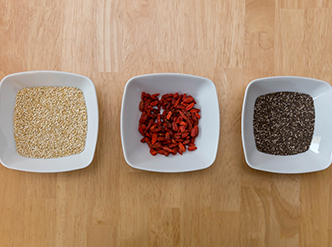
Are ‘superfoods’ really so super?
Are you tempted to buy ‘superfoods’ for health reasons, despite the higher prices? These activities encourage students to explore some of the…

Mealworms are insects with a high nutritional value and could provide a source of animal protein that is more sustainable than traditional livestock.
With the human population reaching new highs every year and expected to reach 10 000 million by 2050, the demand for food, especially animal protein, is steadily increasing.[1] However, most of the traditional livestock consumed by humans have large water and carbon footprints and require a lot of agricultural land. The production of livestock feed generally has a much greater environmental impact that the direct water and land requirements of the animals, and loss of biodiversity is also associated with use of land for the production of animal feed. This makes it crucial to explore more sustainable alternatives, such as mealworms. Mealworms (figure 1) are edible insects that are packed with high-quality proteins, essential amino acids, beneficial fatty acids, and valuable micronutrients.[2] Mealworms also have a smaller ecological footprint compared with conventional livestock, which makes them an excellent option for a nutritious and eco-friendly addition to our diets.[1, 3]
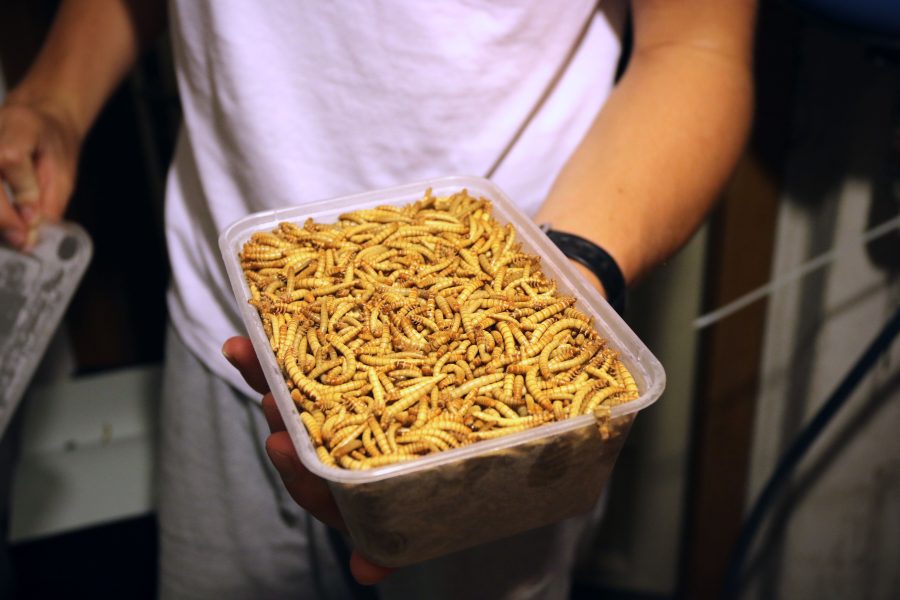
Mealworms are not worms at all, but the larvae of mealworm beetles: black-brown beetles measuring approximately 13–16 mm in length with an oval-shaped body. The larva (mealworms) are yellowish gold in colour and can reach a length of up to 25 mm. The beetles undergo a developmental cycle like that of butterflies, known as complete metamorphosis (figure 2), which comprises four distinct life stages. The beetles originally come from Eurasia but have spread through the world because of human activity.[4] They can often be found as pests in stored food.[5]
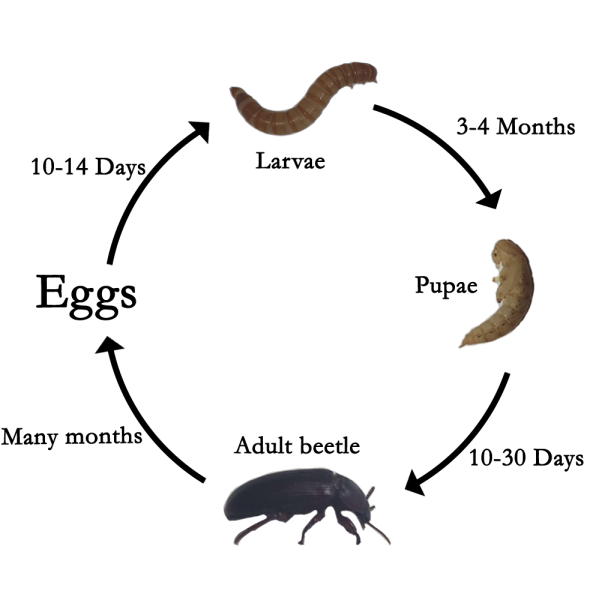
Insects (especially their larvae) are treated as everyday food in many different cultures around the globe, such as mopane worms in Zimbabwe, termites in Kenya, and grasshoppers in Mexico,[7] and are often considered as delicacies – not only because of their taste but also because of their high nutritional value.[2] Mealworms were first used as feed for exotic animals, but in recent years they have garnered attention for human consumption as a sustainable alternative to current protein sources. Of all the different species available, mealworm beetles (T. molitor, figure 3) has proven to be the most suitable for commercial farming.[5]
Mealworms have many potential benefits as a food source. They can efficiently convert food waste into edible protein and have a very high nutritional value. Moreover, they also have a significantly lower ecological impact than traditional livestock; they have much lower water and land requirements, their greenhouse gas emissions are lower, and they have superior feed-to-protein conversion rations compared with pigs, cows, and poultry.[3] Mealworms can have a feed conversion ratio (FCR: the weight of feed consumed divided by the weight gained by the animal) as low as 2.2 but it depends heavily on the feed and life stage.[3] For perspective, in cattle the FCR number is considerably higher, averaging about 8.52.[8] Furthermore, mealworms are commonly fed wheat bran, which is a by-product of the wheat industry, and can also be grown on other organic waste. Mealworms do not require a lot of space, and because of that they can be grown vertically with a minimal carbon dioxide (CO2) footprint, as has been already demonstrated by some companies.[9]
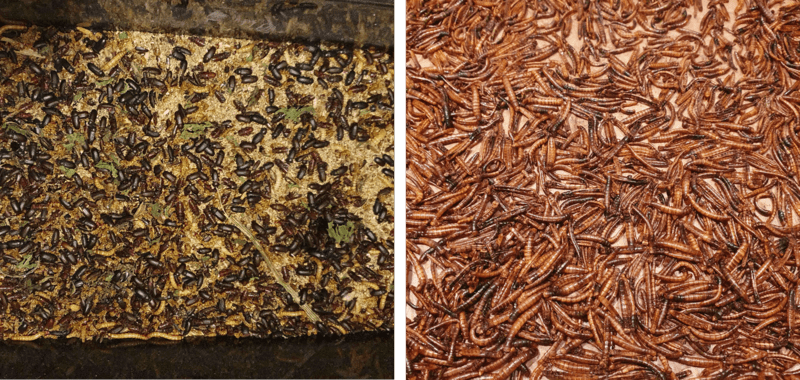
It is tempting to think that mealworms must be nutritionally inferior to red meat, but in fact they are incredibly nutritious. [2, 10–13] They provide more calories and more protein per 100g than conventional meat (figure 4 a,b), and they are not just a protein-packed snack but also full of other micronutrients (figure 4 c).
In addition to minerals, mealworms contain a lot of important fatty acids, such as oleic acid, palmitic acid, linoleic acid, and omega-3 and omega-6 fatty acids[2]. When comparing mealworms to plant protein, such as soybeans, we can see that soybeans are also a great source of many vital nutrients. Although there are environmental issues with soybeans too – in particular, the conversion of forest and other valuable habitats into farmland to grow soy intensively for animal feed[14] – they have a lower ecological impact than animal-based protein. That said, a simple comparison of the protein and fat content to animal-based protein doesn’t tell the full story since the precise amino acid and fatty acid composition differs substantially. Mealworms contain all the essential amino acids, although the digestibility of insect protein is somewhat lower than protein from vertebrate animals. Due to their exoskeletons, mealworms also contain indigestible fibre in the form of chitin, which is also found in mushrooms,[15] and there is some evidence that this could promote healthy gut bacteria.[11]
Mealworms are a versatile food, as they can be incorporated in basically anything from protein bars to whole dishes. They possess a mild, nutty flavour, and can be served whole or dried and ground into a flour that can be added to baked goods to increase the protein content and caloric value. In our own kitchen we have prepared delicious protein bars, Pad Thai, scrambled eggs, and cookies with mealworms or mealworm flour (figure 4).
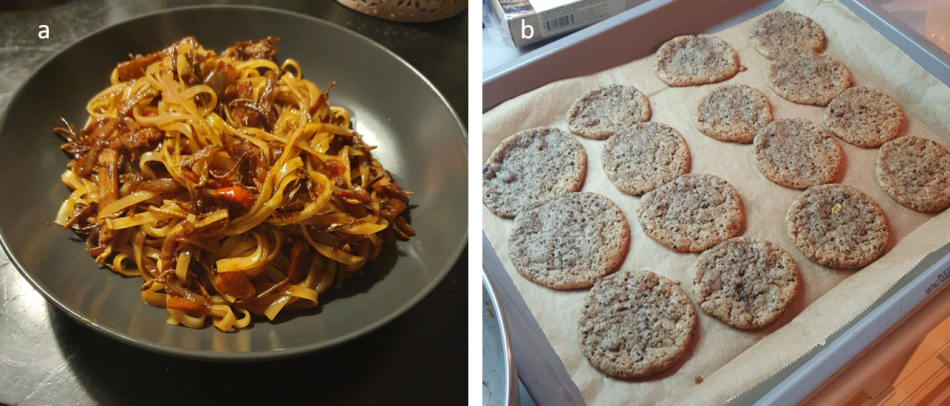
Presenting mealworms as either an alternative to meat or a dietary supplement is still challenging because of their looks – many people are disgusted by them. This problem can be overcome with the use of insect flours, which make mealworms almost invisible when incorporated in a dish. However, it is crucial to recognize the urgent need for sustainable solutions to mitigate the environmental impact of conventional meat production. By shifting our perspective and overcoming prejudices, we can incorporate mealworms and other alternatives to conventional meat into our diets as a way to reduce our ecological footprint. Embracing more sustainable and compassionate food systems is essential for the long-term well-being of both the planet and future generations.[11, 16]
Mealworms are not only protein-packed, but are also praised for their outstanding fertilizing capabilities. Their excretions, called frass (figure 5), are full of nitrogen (N), potassium (K), phosphates (P), and other micronutrients that are essential for the growth of plants, and are a perfect organic substitute for mineral NPK fertilizers, while also being produced sustainably and leaving a smaller impact on the soil.[1]
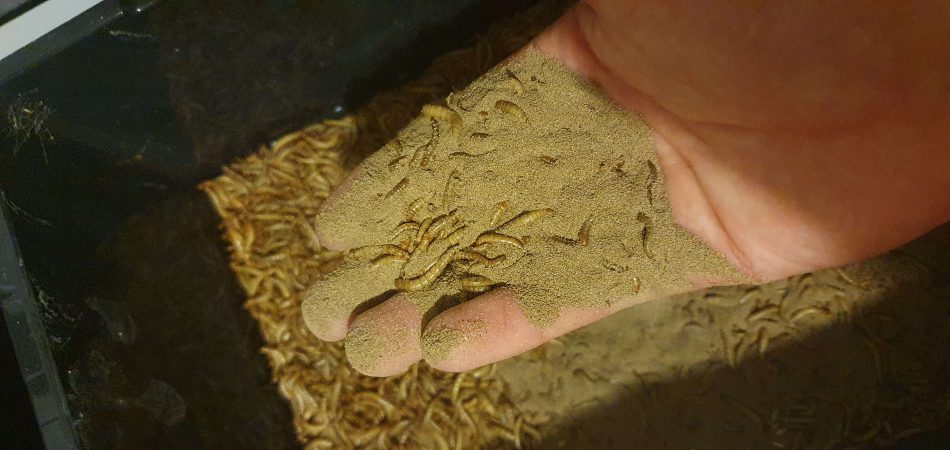
Mealworms have proven to be an outstanding insect that could help address the ever-increasing demand for animal protein while using less space, water, and feed than conventional livestock and producing an excellent organic fertilizer as a waste product. So if you get the chance to try mealworms, leave behind your prejudice and see what they have to offer!
The authors would like to thank the photographer, Maks Sešlar, a student of the Biotechnical Faculty of the University of Ljubljana, Slovenia, for his kind help and the beautiful images. The preparation of this article would not have been possible without help from people from various institutions, from research (academia) to industry. The authors would like to express their sincere gratitude to all those whose work has made and continues to make an important contribution to progress in this field.
[1] Houben D et al. (2020) Potential use of mealworm frass as a fertilizer: Impact on crop growth and soil properties. Scientific Reports 10: 4659. doi: 10.1038/s41598-020-61765-x
[2] Ravzanaadii N et al. (2012) Nutritional value of mealworm, Tenebrio molitor as food source. International Journal of Industrial Entomology 25: 93–98. doi: 10.7852/IJIE.2012.25.1.093
[3] Berggren Å, Jansson A, Low M (2019) Approaching ecological sustainability in the emerging insects-as-food industry. Trends in Ecology & Evolution 34: 132–138. doi: 10.1016/j.tree.2018.11.005
[4] An article on the Macalester College website about the biological features of mealworm beetles: https://www.macalester.edu/ordway/biodiversity/inventory/mealwormbeetle/
[5] Rumbos C I et al. (2020) Evaluation of various commodities for the development of the yellow mealworm, Tenebrio molitor. Scientific Reports 10: 11224. doi: 10.1038/s41598-020-67363-1
[6] Ong S Y et al. (2018) A novel biological recovery approach for PHA employing selective digestion of bacterial biomass in animals. Applied Microbiology and Biotechnology 102: 2117–2127. doi: 10.1007/s00253-018-8788-9
[7] An article listing 10 insect delicacies from around the world: https://www.finedininglovers.com/article/insect-delicacies-around-world
[8] Davison C et al. (2023) Feed conversion ratio (FCR) and performance group estimation based on predicted feed intake for the optimisation of beef production. Sensors 23: 4621. doi: 10.3390/s23104621
[9] Majewski P et al. (2022) Multipurpose monitoring system for edible insect breeding based on machine learning. Scientific Reports 12: 7892. doi: s41598-022-11794-5
[10] Mariod A A (2020) Nutrient composition of mealworm (Tenebrio molitor). In Mariod A A (eds) African edible insects as alternative source of food, oil, protein and bioactive components pp 275–280. Springer. ISBN 978-3-030-32952-5
[11] de Carvalho N M et al. (2019) Study of in vitro digestion of Tenebrio molitor flour for evaluation of its impact on the human gut microbiota. Journal of Functional Foods 59: 101–109. doi: 10.1016/j.jff.2019.05.024
[12] FoodData Central Search Results, Database from U.S. Department of Agriculture: https://fdc.nal.usda.gov/fdc-app.html#/food-details/174032/nutrients
[13] Siemianowska E et al. (2023) Larvae of mealworm (Tenebrio molitor L.) as European novel food. Agricultural Sciences 4: 287–291. doi: 10.4236/as.2013.46041
[14] An article from the World Wide Fund for Nature (WWF) about soy: https://wwf.panda.org/discover/our_focus/food_practice/sustainable_production/soy/
[15] Lenardon M D, Munro C A, Gow N A R (2010) Chitin synthesis and fungal pathogenesis. Current Opinion in Microbiology 13: 416–423. doi: 10.1016/j.mib.2010.05.002
[16] Bonin L, Hafner Korošec J, Marko J (2023) Mokarji (Tenebrio molitor) kot trajnostna super hrana prihodnosti. Trdoživ: Bilten slovenskih terenskih biologov in ljubiteljev narave pp 42–43. Botanično društvo Slovenije. ISSN 2232-5999
The authors present an interesting case for considering Tenebrio as a potential solution to pressing global issues. This article delves into the nutritional and ecological benefits of integrating mealworms into our food systems, outline the nutritional advantages of mealworms, highlighting their high protein content and sustainable production. The potential to address malnutrition and protein deficiency, especially in regions where such challenges persist.
Furthermore, the article addresses the ecological impact of mealworm farming, emphasizing its efficiency and reduced resource consumption compared to conventional livestock agriculture. The potential to alleviate pressure on natural ecosystems is a compelling argument for considering mealworms as an alternative protein source.
Hugo Miguel Ferradeira Pereira de Faria
Biology teacher, Escola Secundária Augusto Gomes (Matosinhos)/CIIMAR- Universidade do Porto

Are you tempted to buy ‘superfoods’ for health reasons, despite the higher prices? These activities encourage students to explore some of the…
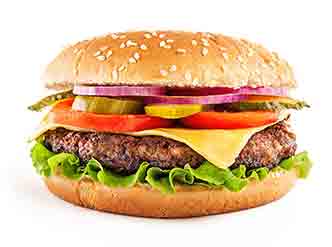
Fresh water is a scarce resource on our planet – but how many of us are aware of how much water is needed to make the foods we eat every…
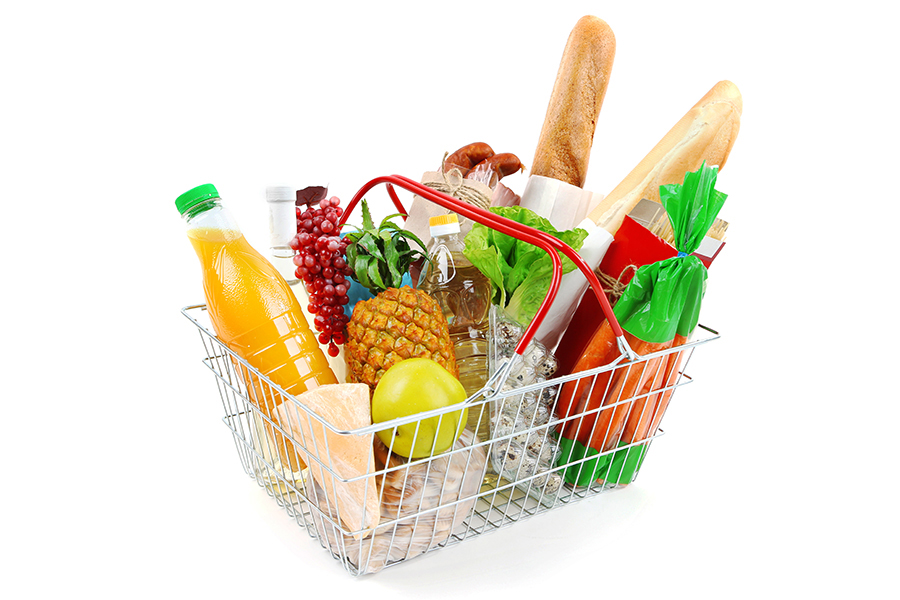
Why is food sold in packaging? Do we really need it? And if so, what materials are best? These questions are more complex than they seem and the…